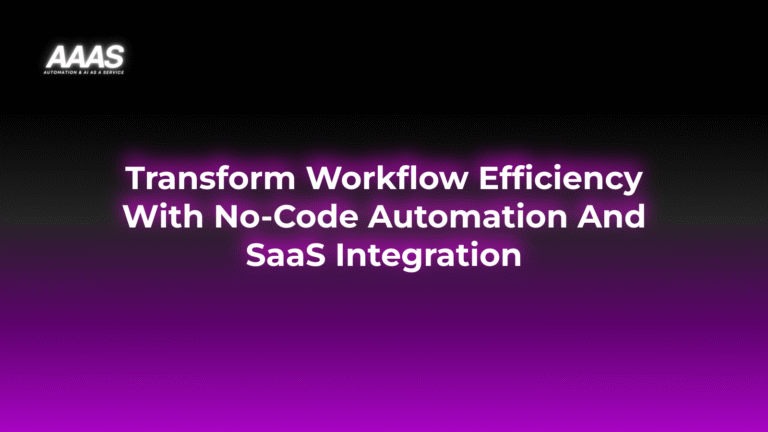Leveraging No-Code Automation and SaaS Integration for Workflow Efficiency
Market Problem: Manual Work and Integration Silos

Organizations today increasingly rely on Software-as-a-Service (SaaS) apps such as CRM, email, project management, and accounting tools. However, most businesses face common obstacles:
- Manual Data Entry: Manually moving data between apps is error-prone and time-consuming.
- Disconnected Systems: Lack of integration leads to workflow silos, redundant tasks, and missed opportunities.
- Rising Operational Costs: Expensive custom integrations and IT overheads reduce agility.
- Lack of Real-Time Data: Delays in syncing data mean slower decision-making and lost productivity.
According to Gartner’s Market Guide, companies waste up to 25% of employee time on repetitive tasks due to poor integration.
Solution: No-Code Automation & SaaS Integration
No-code automation platforms—like Zapier, Make, Workato, and Microsoft Power Automate—enable businesses to build workflows and integrate software with drag-and-drop interfaces.

Key Benefits
- Boost Productivity: Automate repetitive processes to free up teams for high-value tasks.
- Reduce Costs: Eliminate the need for costly custom development or manual labor.
- Increase Efficiency: Accelerate workflows, reduce human error, and enable real-time data flow.
- Scalability: Easily scale automation across departments and processes, no code required.
- Rapid Deployment: Launch integrations in minutes or hours, not weeks or months.
Real Use Cases
1. Sales and CRM Automation
- Automatically capture leads from website forms into Salesforce or HubSpot CRM.
- Trigger follow-up emails, assign leads to reps, and log interactions without manual entry.
2. HR and Onboarding
- Automate collection of new hire documents from Google Drive, notify IT, and set up Slack/Teams accounts in one flow.
3. E-commerce Order Management
- Sync new Shopify orders to accounting tools like Xero, send shipping info to customers, and update inventory automatically.
4. Finance Approvals
- Auto-route purchase requests through approvals using platforms like Airtable and Slack.
5. Customer Support Routing
- Assign support tickets from Zendesk to the right specialist and generate analytics automatically.
Technical Details & Implementation
How No-Code Automation Works
- Connect Apps: Use built-in connectors for over 5,000+ SaaS platforms—email, CRMs, ERPs, financial tools, etc.
- Create Triggers & Actions: Define trigger events (e.g., form submission) and automate follow-up actions (e.g., send notification, update database).
- Visual Builders: Drag-and-drop workflow editors make logic and multi-step automation easy for non-developers.
- Error Handling & Monitoring: Get alerts and logs for exceptions; monitor run history and performance.
Popular Platforms
Security & Compliance
Most platforms meet SOC 2, GDPR, and HIPAA standards. Ensure you verify each tool’s compliance for your industry.
Comparison: No-Code Automation vs Alternatives
| Method | Setup Time | Cost | Flexibility | IT Involvement | Scalability |
|---|---|---|---|---|---|
| No-Code Automation | Minutes/Hours | Low–Moderate | High | Low | High |
| Custom Code Integrations | Weeks/Months | High (Dev Cost) | Very High | Very High | High (Resource Intensive) |
| Manual Processes | None, but ongoing | Time-intensive | Low | None | Low |
| Native SaaS Integrations | Minutes | Low | Limited (Only Built-in) | Low | Medium |
For most organizations, no-code automation offers the best balance between speed, cost, and capability—especially where IT resources are scarce.
No-Code & SaaS Integration Pricing (2025)
| Platform | Starting Monthly Price | Free Tier | Usage Limitations |
|---|---|---|---|
| Zapier | $19.99 | Yes (100 tasks/month) | Workflow complexity, task runs |
| Make | $10.59 | Yes (1,000 ops/month) | Scenario runs, API calls |
| Microsoft Power Automate | $15 | Yes (limited) | Premium connectors, flow runs |
| Workato | Custom (Pro+) | No | Enterprise focus |
| Tray.io | Custom | No | Enterprise automation |
ROI-Focused Practical Examples
- Lead Management Automation: Company with 2,000 monthly leads saves 40 hours/month by integrating web forms → CRM → email campaigns; labor cost savings ≈ $1,200/month.
- Finance Team Automation: Automating invoice approvals cuts average processing time by 60%. If team processes 500 invoices/month, the ROI can exceed 300% annually.
- Customer Support Routing: Automating support ticket assignment reduces response time by 35%, leading to higher NPS and retention rates.
ROI Formula
ROI (%) = [(Efficiency Gains + Cost Savings – Investment Cost) / Investment Cost] x 100
Use tools like the Zapier ROI Calculator to estimate potential returns on automation spend.
How to Set Up No-Code Automation & Integration
- Audit your current SaaS tools and workflow bottlenecks.
- Select a no-code automation platform based on your app ecosystem and volume.
- Choose pre-built app connectors for your stack (CRMs, HR, finance, etc.).
- Map workflow triggers, actions, and conditions using the visual builder.
- Test automations in sandbox mode; monitor for errors and optimize logic.
- Train relevant staff; document key workflows and support contacts.
- Monitor performance and scalability; set up alerts for failed automations.
For a detailed walkthrough, see our [InternalLink:saas-workflow-automation-step-by-step|Step-by-Step SaaS Automation Setup Guide].
Pros and Cons
| Pros | Cons |
|---|---|
|
|
Expert Tips for Maximum Efficiency
- Start Small: Automate high-friction, repetitive tasks first before scaling up.
- Document Workflows: Keep detailed records for handover, auditing, and compliance.
- Use Conditional Logic: Advanced platforms support if/then logic for smarter workflows.
- Monitor Usage: Set up dashboards and notifications for failed automations or quota limits.
- Prioritize Security: Use secure connections (OAuth, SSO), and regularly audit permissions.
- Review Integrations: Periodically reassess workflows to remove redundancies and optimize.
Frequently Asked Questions
- Can no-code automation replace all custom integrations?
- No, but it covers 80–90% of standard business processes without coding. Complex, highly bespoke logic may require traditional development.
- Are workflows secure on no-code platforms?
- Major providers offer bank-level encryption and compliance, but always check certifications (SOC 2, ISO, GDPR) and control permissions accordingly.
- How much technical skill is needed?
- Minimal. Most platforms use intuitive, visual editors; basic logical thinking is helpful.
- What if my app isn’t supported?
- Many platforms support webhooks or custom API connectors for niche apps.
- How do I scale automations?
- Upgrade plan tiers for higher task/operation limits and use modular workflow design.
References
Last Updated
2025-10-14T09:00:54.113Z








